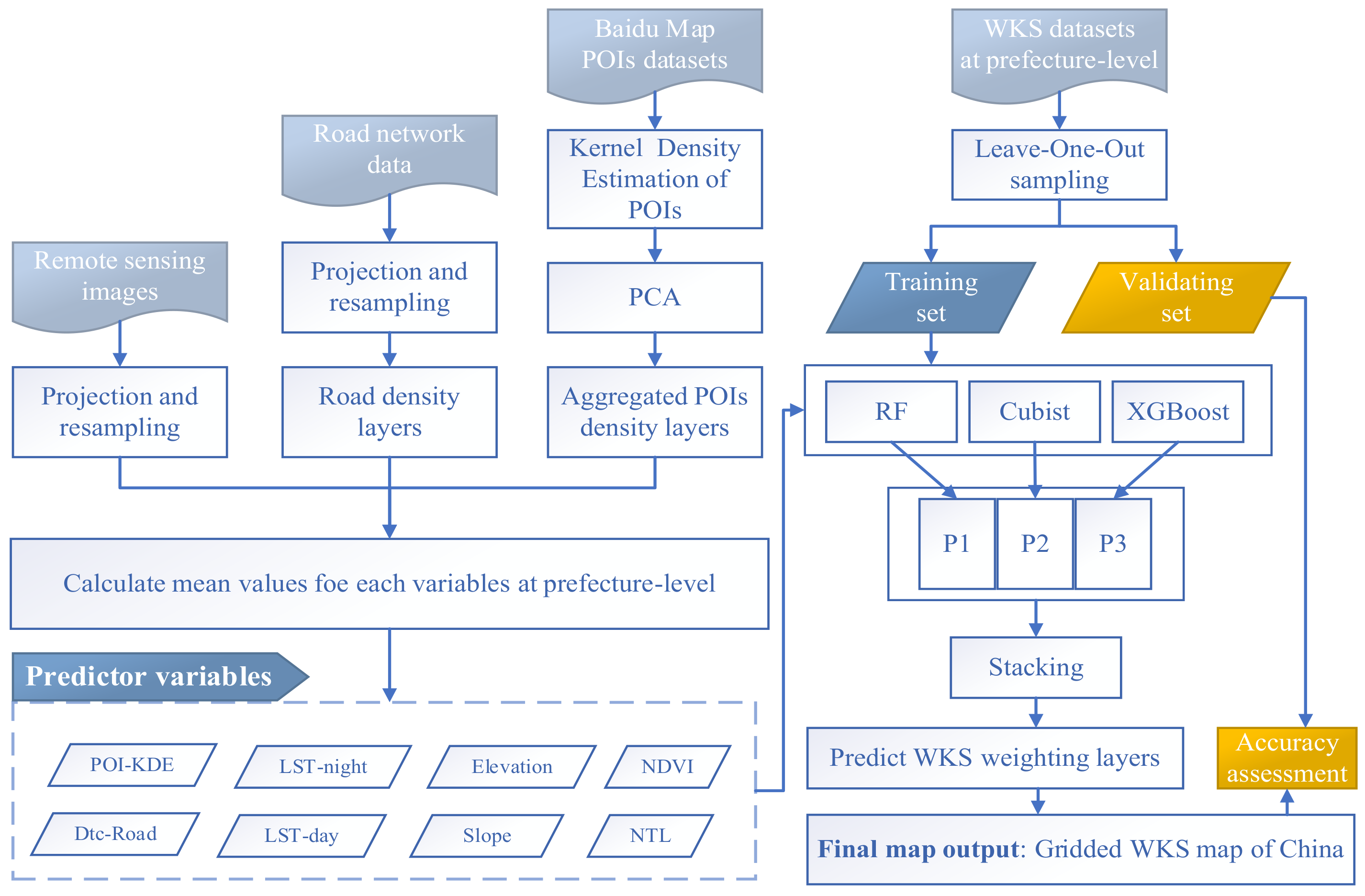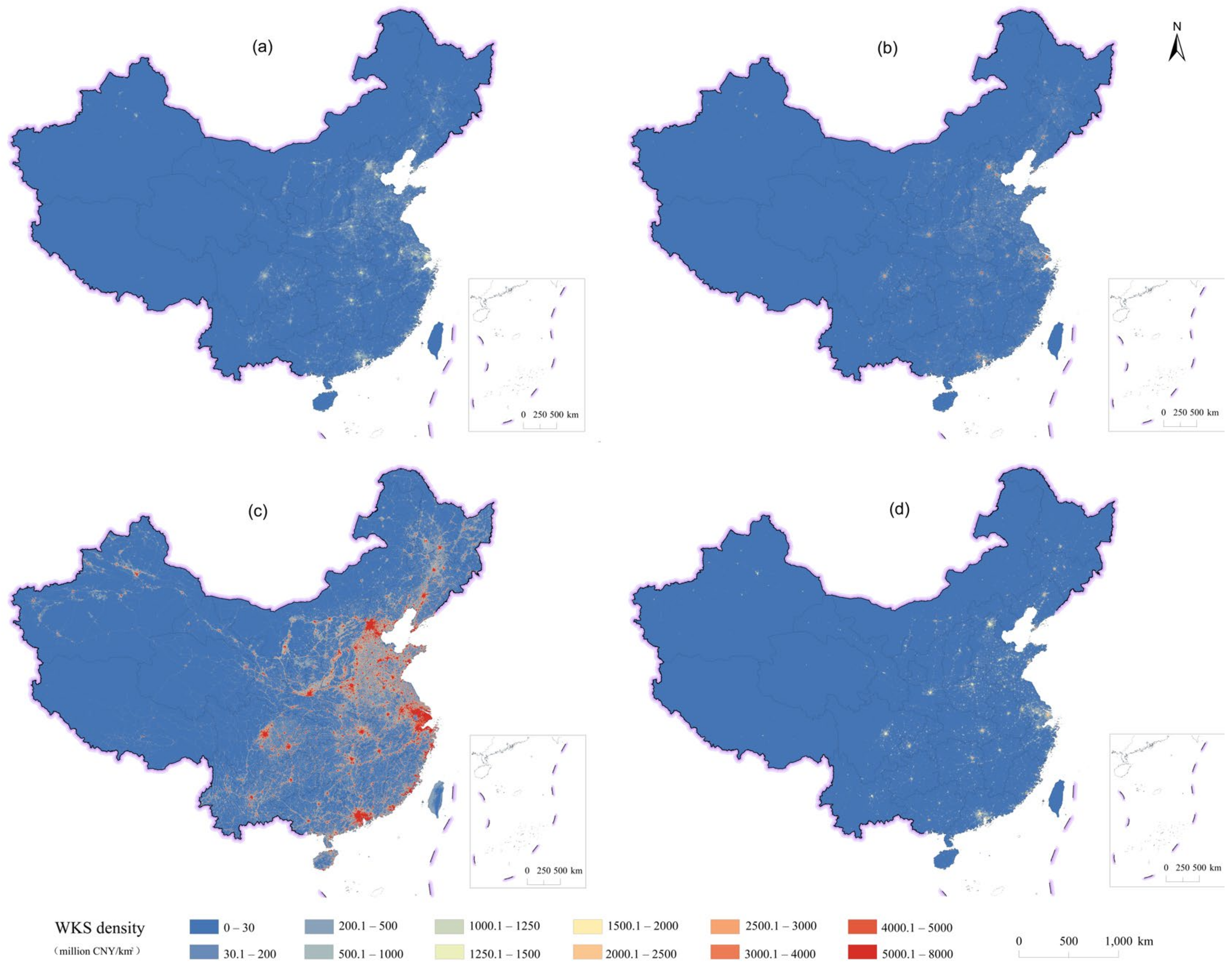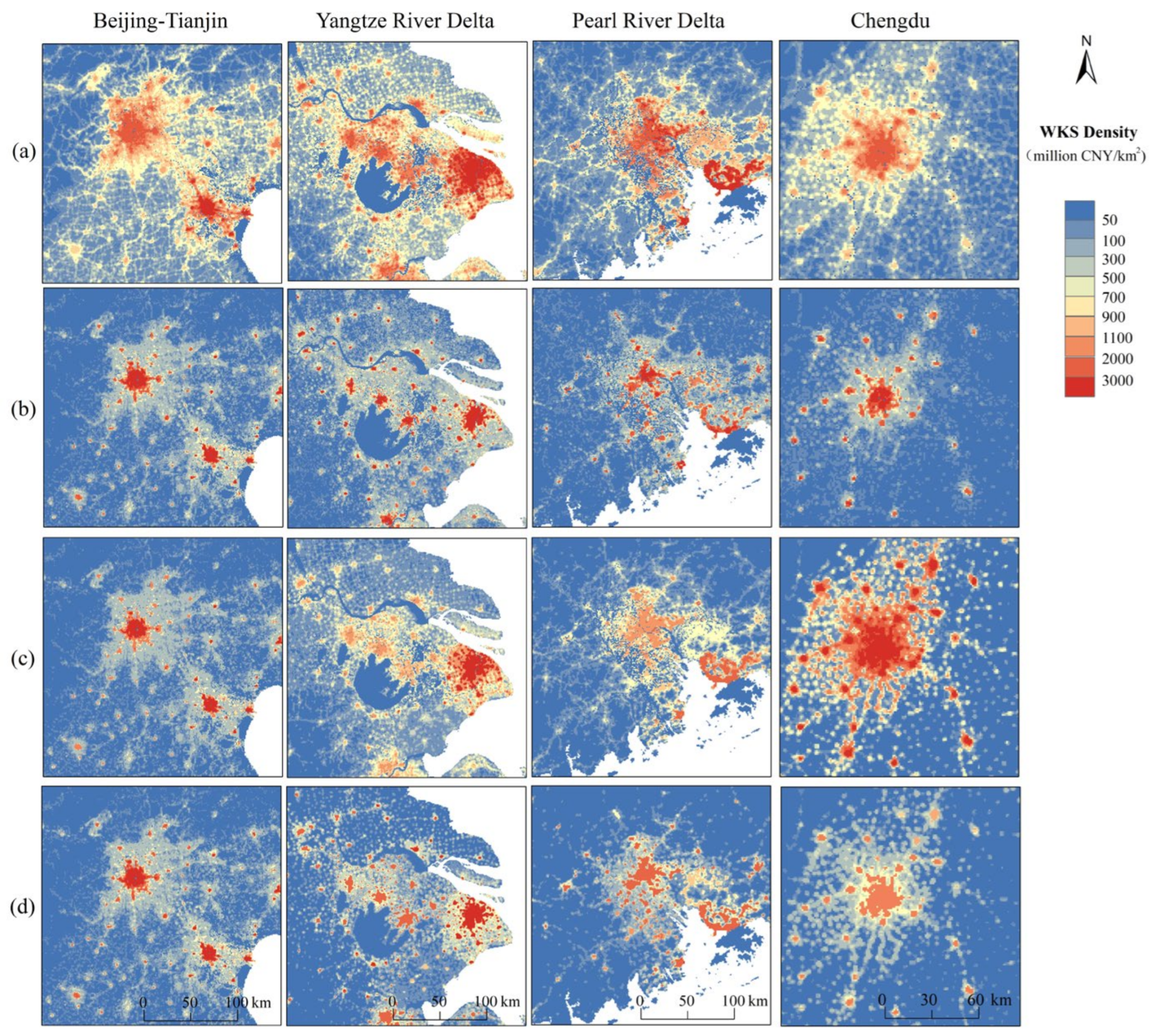China’s Wealth Capital Stock Mapping via Machine Learning Methods
Abstract
:1. Introduction
2. Data and Methodology
2.1. Data Collection and Preprocessing
2.1.1. WKS Data
2.1.2. Remote Sensing Datasets
- a.
- NTL data
- b.
- Vegetation index
- c.
- Land surface temperature (LST) data
- d.
- Digital elevation model (DEM) data
2.1.3. Road Network Data
2.1.4. POI Data
2.2. Methodology
2.2.1. Building the Base Models
2.2.2. Ensemble Learning and Model Fitting
2.2.3. Dasymetric WKS Mapping
2.2.4. Accuracy Validation
3. Results
3.1. Accuracy Assessment
3.2. Gridded WKS Maps and Model Comparison
4. Discussion
5. Conclusions
Author Contributions
Funding
Data Availability Statement
Acknowledgments
Conflicts of Interest
References
- Holz, C.A.; Sun, Y. Physical capital estimates for China’s provinces, 1952–2015 and beyond. China Econ. Rev. 2018, 51, 342–357. [Google Scholar] [CrossRef] [Green Version]
- Seifert, I.; Thieken, A.H.; Merz, M.; Borst, D.; Werner, U. Estimation of industrial and commercial asset values for hazard risk assessment. Nat. Hazards 2010, 52, 453–479. [Google Scholar] [CrossRef]
- Bono, A.D.; Chatenoux, B.; Herold, C.; Peduzzi, P. Global Assessment Report on Disaster Risk Reduction 2013: From Shared Risk to Shared Value—The Business Case for Disaster Risk Reduction; Université de Genève: Geneva, Switzerland, 2013. [Google Scholar]
- Chen, Q.; Ye, T.; Zhao, N.; Ding, M.; Ouyang, Z.; Jia, P.; Yue, W.; Yang, X. Mapping China’s regional economic activity by integrating points-of-interest and remote sensing data with random forest. EPB Urban Anal. City Sci. 2020. [Google Scholar] [CrossRef]
- Wu, J.; Li, Y.; Li, N.; Shi, P. Development of an Asset Value Map for Disaster Risk Assessment in China by Spatial Disaggregation Using Ancillary Remote Sensing Data. Risk Anal. 2018, 38, 17–30. [Google Scholar] [CrossRef] [PubMed]
- Yang, X.; Yao, C.; Chen, Q.; Ye, T.; Jin, C. Improved Estimates of Population Exposure in Low-Elevation Coastal Zones of China. Environ. Res. Public Health 2019, 16, 4012. [Google Scholar] [CrossRef] [Green Version]
- Jin, C.; Zhang, Y.; Yang, X.; Zhao, N.; Ouyang, Z.; Yue, W. Electronic Power Consumption. Remote Sens. 2021, 13, 1058. [Google Scholar] [CrossRef]
- Ye, T.; Zhao, N.; Yang, X.; Ouyang, Z.; Liu, X.; Chen, Q.; Hu, K.; Yue, W.; Qi, J.; Li, Z.; et al. Improved population mapping for China using remotely sensed and points-of-interest data within a random forests model. Sci. Total Environ. 2018, 658, 936–946. [Google Scholar] [CrossRef]
- Gao, S.; Janowicz, K.; Couclelis, H.J.T.I.G. Extracting urban functional regions from points of interest and human activities on location-based social networks. Trans. GIS 2017, 21, 446–467. [Google Scholar] [CrossRef]
- Hu, T.; Yang, J.; Li, X.; Gong, P. Mapping Urban Land Use by Using Landsat Images and Open Social Data. Remote Sens. 2016, 8, 151. [Google Scholar] [CrossRef]
- Jiang, S.; Alves, A.; Rodrigues, F.; Ferreira, J.J.; Pereira, F.C. Mining point-of-interest data from social networks for urban land use classification and disaggregation. Comput. Environ. Urban Syst. 2015, 53, 36–46. [Google Scholar] [CrossRef]
- Song, J.; Lin, T.; Li, X.; Prishchepov, A.V. Mapping Urban Functional Zones by Integrating Very High Spatial Resolution Remote Sensing Imagery and Points of Interest: A Case Study of Xiamen, China. Remote Sens. 2018, 10, 1737. [Google Scholar] [CrossRef] [Green Version]
- Long, Y.; Shen, Y.; Jin, X. Mapping Block-Level Urban Areas for All Chinese Cities. Ann. Am. Assoc. Geogr. 2015, 106, 96–113. [Google Scholar] [CrossRef] [Green Version]
- Yang, X.; Lin, L.; Zhang, Y.; Ye, T.; Chen, Q.; Jin, C.; Ye, G. Spatially Explicit Assessment of Social Vulnerability in Coastal China. Sustainability 2019, 11, 5075. [Google Scholar] [CrossRef] [Green Version]
- Bakillah, M.; Liang, S.; Mobasheri, A.; Jokar Arsanjani, J.; Zipf, A. Fine-resolution population mapping using OpenStreetMap points-of-interest. Int. J. Geogr. Inf. Sci. 2014, 28, 1940–1963. [Google Scholar] [CrossRef]
- Yao, Y.; Liu, X.; Li, X.; Zhang, J.; Liang, Z.; Mai, K.; Zhang, Y. Mapping fine-scale population distributions at the building level by integrating multisource geospatial big data. Int. J. Geogr. Inf. Syst. 2017, 31, 1220–1244. [Google Scholar] [CrossRef]
- Wu, J.; Li, N.; Shi, P. Benchmark wealth capital stock estimations across China’s 344 prefectures: 1978 to 2012. China Econ. Rev. 2014, 31, 288–302. [Google Scholar] [CrossRef]
- Yu, B.; Shi, K.; Hu, Y.; Huang, C.; Chen, Z.; Wu, J. Poverty Evaluation Using NPP-VIIRS Nighttime Light Composite Data at the County Level in China. IEEE J. Sel. Top. Appl. Earth Obs. Remote Sens. 2017, 8, 1217–1229. [Google Scholar] [CrossRef]
- Xi, L.; Xu, H.; Chen, X.; Li, C. Potential of NPP-VIIRS Nighttime Light Imagery for Modeling the Regional Economy of China. Remote Sens. 2013, 5, 3057–3081. [Google Scholar]
- Shi, K.; Yu, B.; Hu, Y.; Huang, C.; Chen, Y.; Huang, Y.; Chen, Z.; Wu, J. Modeling and mapping total freight traffic in China using NPP-VIIRS nighttime light composite data. GISciences Remote Sens. 2015, 52, 274–289. [Google Scholar] [CrossRef]
- Shi, K.; Huang, C.; Yu, B.; Yin, B.; Huang, Y.; Wu, J. Evaluation of NPP-VIIRS night-time light composite data for extracting built-up urban areas. Remote Sens. Lett. 2014, 5, 358–366. [Google Scholar] [CrossRef]
- Holben, B.N. Characteristics of maximum-value composite images from temporal AVHRR data. Int. J. Remote Sens. 1986, 7, 1417–1434. [Google Scholar] [CrossRef]
- Yao, Y.; Li, X.; Liu, X.; Liu, P.; Liang, Z.; Zhang, J.; Mai, K. Sensing spatial distribution of urban land use by integrating points-of-interest and Google Word2Vec model. Int. J. Geogr. Inf. Sci. 2017, 31, 825–848. [Google Scholar] [CrossRef]
- Buch-Kromann, T.; Nielsen, J.P.; Guillen, M.; Bolancé, C. Kernel density estimation for heavy-tailed distributions using the champernowne transformation. Statistics 2005, 39, 503–516. [Google Scholar] [CrossRef]
- Mitchell, T.M. Machine Learning; Machine Learning: Littleton, CO, USA, 2003. [Google Scholar]
- Liaw, A.; Wiener, M. Classification and Regression by randomForest. Comput. Sci. 2002, 2, 18–22. [Google Scholar]
- Breiman, L. Out-Of-Bag Estimation; ftp.stat.berkeley.edu: Berkeley, CA, USA, 1996. [Google Scholar]
- Walton, J.T. Subpixel urban land cover estimation: Comparing cubist, random forests, and support vector regression. Photogramm. Eng. Remote Sens. 2008, 74, 1213–1222. [Google Scholar] [CrossRef] [Green Version]
- Chen, T.; Guestrin, C. XGBoost: A Scalable Tree Boosting System. In Proceedings of the 22nd ACM SIGKDD International Conference, San Francisco, CA, USA, 13–17 August 2016. [Google Scholar]
- Folberth, C.; Baklanov, A.; Balkovič, J.; Skalský, R.; Khabarov, N.; Obersteiner, M. Spatio-temporal downscaling of gridded crop model yield estimates based on machine learning. Agric. For. Meteorol. 2018, 264, 1–15. [Google Scholar] [CrossRef] [Green Version]
- Jia, P.; Gaughan, A. Dasymetric modeling: A hybrid approach using land cover and tax parcel data for mapping population in Alachua County, Florida. Appl. Geogr. 2016, 66, 100–108. [Google Scholar] [CrossRef]
- Eicher, C.L.; Brewer, C.A. Dasymetric Mapping and Areal Interpolation: Implementation and Evaluation. Cartogr. Geogr. Inf. Sci. 2001, 28, 125–138. [Google Scholar] [CrossRef]
- Mennis, J. Dasymetric Mapping for Estimating Population in Small Areas. Geogr. Compass 2010, 3, 727–745. [Google Scholar] [CrossRef]
- Okoli, K.; Breinl, K.; Brandimarte, L.; Botto, A.; Volpi, E.; Di Baldassarre, G. Model averaging versus model selection: Estimating design floods with uncertain river flow data. Hydrol. Sci. J. 2018, 63, 1913–1926. [Google Scholar] [CrossRef] [Green Version]
- Kuncheva, L.I. Combining Pattern Classifiers: Methods and Algorithms; John Wiley & Sons: New York, NY, USA, 2004. [Google Scholar]
- Bilham, R. Lessons from the Haiti earthquake. Nature 2010, 463, 878–879. [Google Scholar] [CrossRef]
- Linde, A.; Bubeck, P.; Dekkers, J.; Moel, H.D.; Aerts, J.J.N.H. Future flood risk estimates along the river Rhine. Nat. Hazards Earth Syst. Sci. 2011, 11, 459–473. [Google Scholar] [CrossRef]




| RF | Cubist | XGBoost | Stacking | |
|---|---|---|---|---|
| MRE | 4.183% | 4.248% | 4.044% | 3.798% |
| RMSE | 0.371293 | 0.374573 | 0.361901 | 0.337656 |
| Train | RF | Cubist | XGBoost | Stacking | |
|---|---|---|---|---|---|
| Lower | 1.495 | 2.210 | 0.181 | 1.777 | 1.213 |
| Upper | 11.647 | 7.944 | 8.961 | 8.820 | 8.550 |
Disclaimer/Publisher’s Note: The statements, opinions and data contained in all publications are solely those of the individual author(s) and contributor(s) and not of MDPI and/or the editor(s). MDPI and/or the editor(s) disclaim responsibility for any injury to people or property resulting from any ideas, methods, instructions or products referred to in the content. |
© 2023 by the authors. Licensee MDPI, Basel, Switzerland. This article is an open access article distributed under the terms and conditions of the Creative Commons Attribution (CC BY) license (https://creativecommons.org/licenses/by/4.0/).
Share and Cite
Ren, L.; Li, F.; Chen, B.; Chen, Q.; Ye, G.; Yang, X. China’s Wealth Capital Stock Mapping via Machine Learning Methods. Remote Sens. 2023, 15, 689. https://doi.org/10.3390/rs15030689
Ren L, Li F, Chen B, Chen Q, Ye G, Yang X. China’s Wealth Capital Stock Mapping via Machine Learning Methods. Remote Sensing. 2023; 15(3):689. https://doi.org/10.3390/rs15030689
Chicago/Turabian StyleRen, Lulu, Feixiang Li, Bairu Chen, Qian Chen, Guanqiong Ye, and Xuchao Yang. 2023. "China’s Wealth Capital Stock Mapping via Machine Learning Methods" Remote Sensing 15, no. 3: 689. https://doi.org/10.3390/rs15030689






